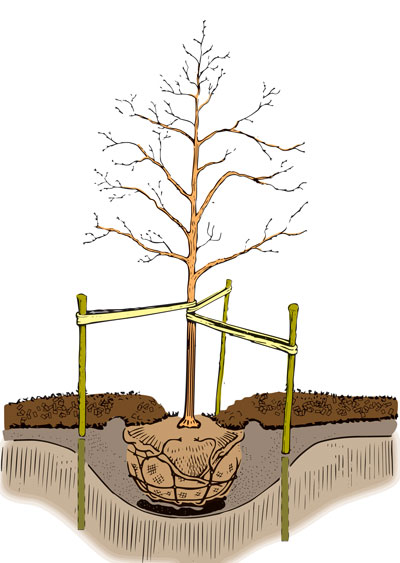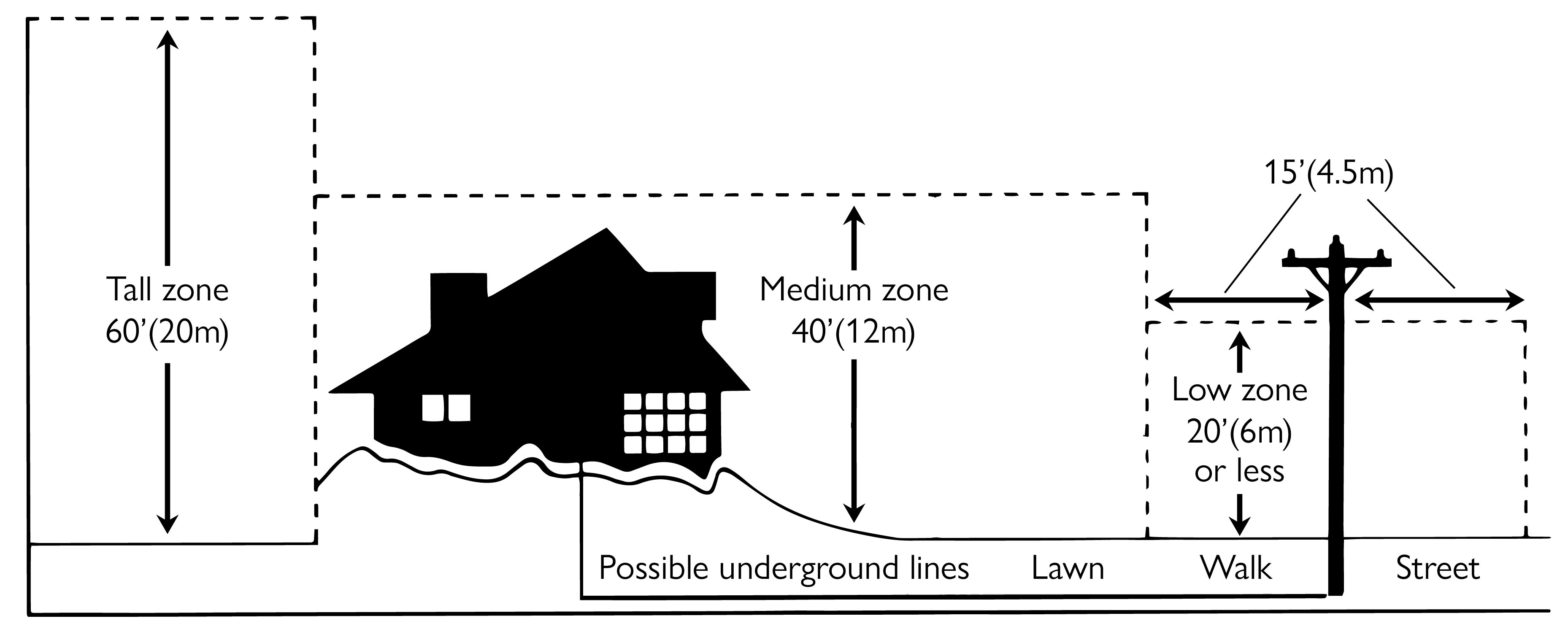Planting a Tree

Trees are an investment. How well that investment grows depends on several factors including, the type of tree planted, its location and the care provided. Getting your new tree off to a healthy start will help the tree mature to its full size and ensures it will provide environmental, economic, and social benefits throughout its lifetime.
Learn more about planting a new tree.
When to Plant
Dormant seasons, the fall after leaf drop and early spring before bud break, are ideal times to plant new trees. Be sure the weather conditions are cool and allow time for new plants to establish roots in the new location before spring rains and summer heat stimulate new top growth. Healthy bailed and burlapped or container trees can be planted throughout the growing season. In areas where trees grow year round, tropical and subtropical climates, any time is a good time to plant a new tree as long as sufficient water is available.
Planting Stress
Transplant shock is a state of slowed growth and reduced vitality following transplanting and can affect balled-and-burlapped trees lose a causing them to lose a significant portion of their root system when dug at the nursery. Container trees may also experience transplant shock. Proper site preparation, careful handling to prevent further root damage, and good follow-up care reduces transplant shock and promotes faster recovery.
How to Plant a Tree

Carefully follow these nine steps to help your tree establish quickly in its new location:
1. The trunk flare is where the trunk expands at the base of the tree. Ensure trunk flare is partially visible after the tree is planted. Remove excess soil prior to planting if flare is not visible.
2. Dig a shallow, broad planting hole. Holes should be 2–3 times wider than the root ball, but only as deep as the root ball.
3. If wrapped, remove any cover from around the root ball and trunk to facilitate root growth. Remove wire basket or cut one or two rings off so it is low-profile and will not interfere with future root growth. Inspect tree root ball for circling roots and straighten, cut, or remove them. Expose the trunk flare if necessary.
4. Place the tree at the proper height. When placing the tree in the hole, lift by the root ball, not the trunk. The majority of tree’s roots develop in the top 12 inches (30 cm) of soil. Planting too deep can be harmful to the tree.
5. Straighten the tree in the hole. Before filling the hole, have someone examine the tree from several angles to confirm it is straight.
6. Fill the hole gently but firmly. Pack soil around the base of the root ball to stabilize it.
Fill the hole firmly to eliminate air pockets. Further reduce air pockets by watering periodically while backfilling. Avoid fertilizing at the time of planting.
7. If staking is necessary, three stakes or underground systems provide optimum support. Studies have shown that trees develop stronger trunks and roots if they are not staked; however, it may be required when planting bare root stock or on windy sites. Remove stakes after first year of growth.
8. Mulch the base of the tree. Place a 2–3 inch (5–7.5 cm) layer of mulch, but be sure not to pile much right against the trunk. A mulch-free area of 1–2 inches (2.5–5 cm) wide at the base of the tree will reduce moist bark and prevent decay.
9. Provide follow-up care. Keep the soil moist by watering at least once a week, barring rain, and more frequently during hot, windy weather. Continue until mid-fall, tapering off as lower temperatures require less-frequent watering.
Other follow-up care to consider:
• Minor pruning of branches damaged during the planting process may be required.
• Prune sparingly after planting. Delay corrective pruning until a full season of growth.
• If trunk wrapping is necessary, use biodegradable materials and wrap from the bottom.
Consult your local ISA Certified Arborist® or a tree care or garden center professional for assistance regarding your tree.
Note: Before you begin planting your tree, be sure you have located all underground utilities prior to digging. 811 is the US national call-before-you-dig phone number. Anyone who plans to dig should call 811 or go to their state 811 center’s website.
Right Tree – Right Place

Proper tree placement can enhance your property and prevent costly maintenance and repairs down the road. Consider utility lines, the side walk and driveways when choosing a location. A local arborist or tree care professional, utility company, local nursery, or county extension office can help with proper tree placement.

Mulching
Mulching is one of the most beneficial practices a homeowner can use for better tree health. Mulches are applied to the soil surface to maintain moisture and improve soil conditions. However, if misapplied, mulch may have little, or even negative, impact on the trees in your landscape.
The benefits of proper mulching include:
- Reduces soil moisture loss through evaporation.
- Controls weed germination and growth.
- Insulates soil, protecting roots from extreme summer and winter temperatures.
Learn more about proper mulching techniques
Avoiding Tree and Utility Conflicts

Determining where to plant a tree is a decision that should not be taken lightly. Many factors should be considered prior to planting. When planning what type of tree to plant, remember to look up and look down to determine where the tree will be located in relation to overhead and underground utility lines.
Learn more about planting trees near utilities.
Overhead Lines
Overhead utility lines are easy to spot, yet often overlooked. Planting tall-growing trees under or near these lines eventually requires your utility provider to prune them to maintain safe clearance from the wires. This pruning may result in the tree having an unnatural appearance. Periodic pruning can also lead to a shortened life span for the tree.
Tall-growing trees near overhead lines can cause service interruptions when trees contact wires. Children or adults climbing in these trees can be severely injured or even killed if they come in contact with the wires. Proper selection and placement of trees in and around overhead utilities can eliminate potential public safety hazards, reduce expenses for utilities and their customers, and improve landscape appearance.
Underground Lines
Trees consist of much more than what you see above ground. Many times, the root area below ground is larger than the branch spread. Electric, gas, water, and sewer lines installed underground can be compromised by tree roots. Roots commonly spread many times the breadth of the tree crown and can extend out farther than the height of a tree.
Locating Underground Utilities
The greatest danger to underground utilities occurs during planting. Accidental digging into underground utilities can cause costly repairs to restore interrupted service or result in injury or loss of life. Before digging call your utility company or locator service to make sure you have located underground utilities. Never assume that utilities are buried deeper than you plan to dig. Locating underground utilities before digging is often required by law.